It does look pretty clean to me.. Richy what do you think?
Edit: Actually I noticed the scope is running at 100kS/Sec - so do you have access to a pure analog scope? Or can you select a much higher sampling rate? This low sampling rate may be misleading as RF oscillations probably can't be seen at all.
Worst case take a look at one single cycle at 1kHz or higher and continue to window in at progressively higher sample rates looking at progressively smaller parts of the sine wave across the entire cycle for HF content riding on your sine wave - note also that the amplitude may be much lower than the signal you are looking at. (Higher vertical gains may be used as long as you do not overload the vertical amplifier.)
Edit: Actually I noticed the scope is running at 100kS/Sec - so do you have access to a pure analog scope? Or can you select a much higher sampling rate? This low sampling rate may be misleading as RF oscillations probably can't be seen at all.
Worst case take a look at one single cycle at 1kHz or higher and continue to window in at progressively higher sample rates looking at progressively smaller parts of the sine wave across the entire cycle for HF content riding on your sine wave - note also that the amplitude may be much lower than the signal you are looking at. (Higher vertical gains may be used as long as you do not overload the vertical amplifier.)
Last edited:
Here is a better image of that 1Khz square wave.
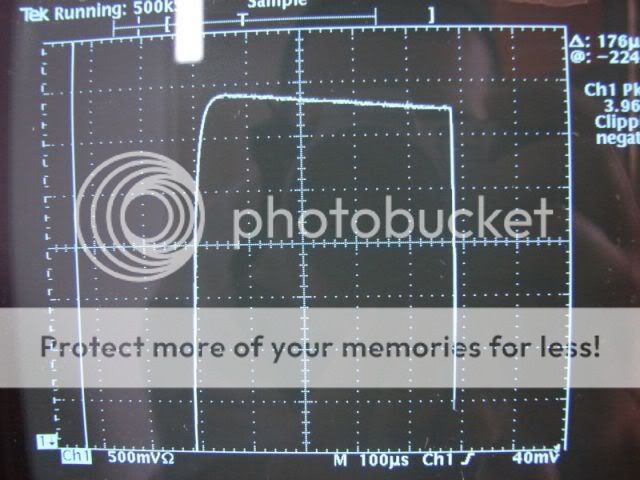
Try blowing up just the peak and just at the leading edge to a couple of dozen uS or so. 500kS/S rate is still too slow to show low level HF oscillations at the peak. Also try with a sine wave as well.
I have heard plenty of OPT's that sing or talk. The cheap-o SE OPT's that are in my 854SE can be heard plainly anywhere in the room. One is much louder than the other. This is not unusual, and won't be heard when a speaker is connected.
I have a pair of surplus Plitron 400 watt P-P OPT's that are not potted. They are covered only with mylar tape. They are dead quiet at normal levels and make a slight sound when driven to 250 watts loaded by a resistor. They are plainly audible when the same amp is driven to clipping (300+ watts).
I have a pair of surplus Plitron 400 watt P-P OPT's that are not potted. They are covered only with mylar tape. They are dead quiet at normal levels and make a slight sound when driven to 250 watts loaded by a resistor. They are plainly audible when the same amp is driven to clipping (300+ watts).
Response on the 4ohm speaker with 1Khz sine
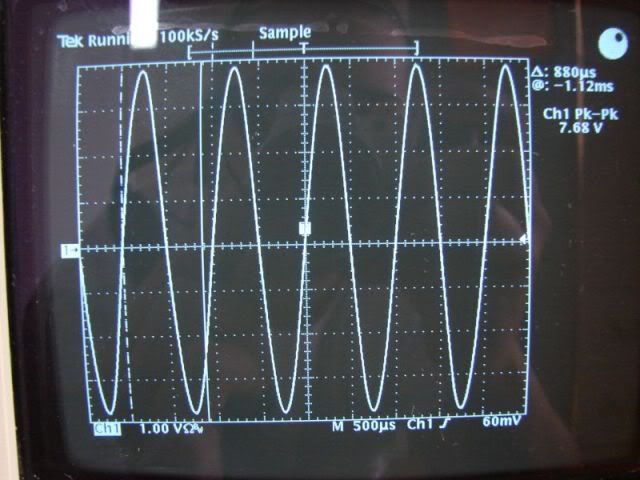
1Khz square wave
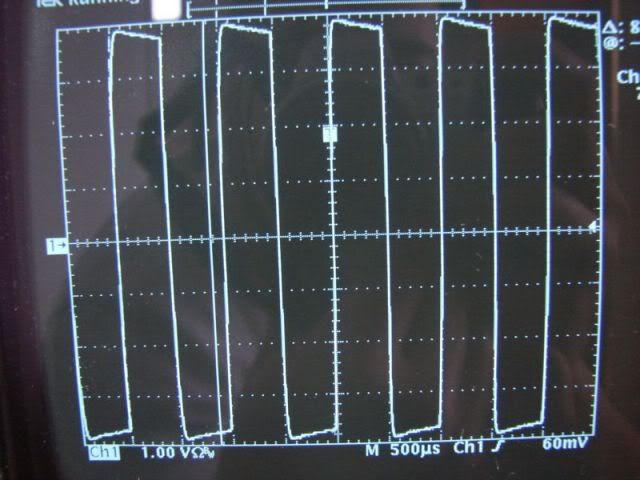
10KHz square wave, the rounding off is from the RC network on the input stage not the output stage
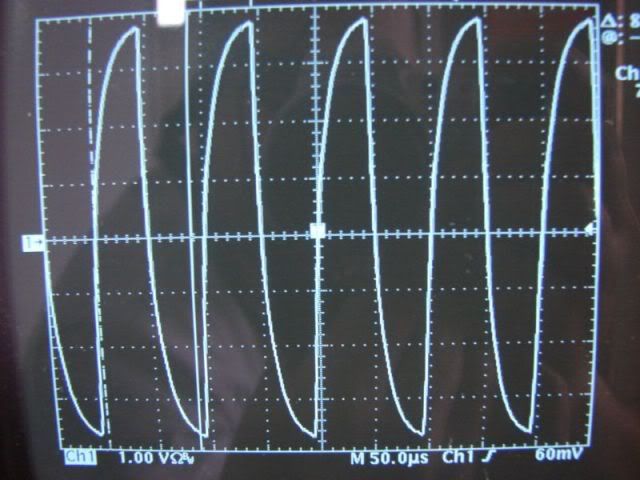
Those waveforms look pretty typical, esp the lower with a heavy RC. I must confess that any HF would have been quite visible even with reduced scope b/w and quickly verified by measuring cathode currents.
Are we barking up the wrong tree ?
I'm curious. Returning to Kevin's post #46. The toroidal o/p mounting. This one is unanswered.
How have you fixed the o/p toroid cans ? Is it the same screw that contacts the chassis and the cans in one and the can skirts also making contact with the chassis ? I'm thinking of a one turn s/c scenario. Is the singing the same without the can fitted ?
BTW. Refer to Circuit diagram; The concertina top/lower has 0.22uF coupling caps fitted. If amp suffers from subsonic LF oscillation symptoms with global nfb connected then these cap values have to reduced by 1/2 but wait till symptoms arise before making this move.
richy
Ok good to know that the OPT noise I am hearing is semi-typical. My real concern at this moment is the headache/pressure i feel when the amp is on, I still have to determine if this is real or just paranoia.
I must plead ignorance on the OPT mounting, I am not sure what you are asking me or what information you are trying to obtain (I am a CMOS guy who has likely built his last tube project). All of the iron is manufactured by Plitron. They are encapsulated in some black gunk, and in the middle of the gunk on the under side is a threaded hole. The threaded hole comes supplied with a mounting bolt and lock washer. On the bottom of the donuts is a rubber matt. Here is a pictures of all the bits from when i first started way back, you can kinda see what i am talking about on the OPT
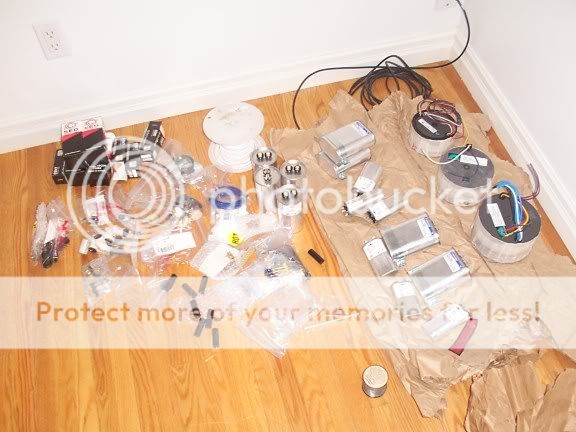
I must plead ignorance on the OPT mounting, I am not sure what you are asking me or what information you are trying to obtain (I am a CMOS guy who has likely built his last tube project). All of the iron is manufactured by Plitron. They are encapsulated in some black gunk, and in the middle of the gunk on the under side is a threaded hole. The threaded hole comes supplied with a mounting bolt and lock washer. On the bottom of the donuts is a rubber matt. Here is a pictures of all the bits from when i first started way back, you can kinda see what i am talking about on the OPT

Here is the output stage in its current state
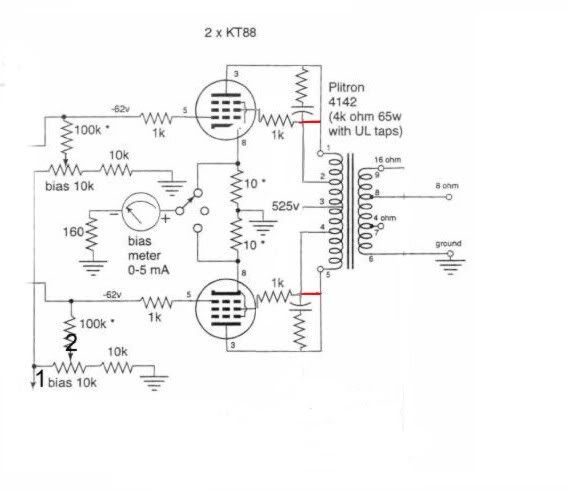
If I am not mistaken if i do decide to try out triode mode all I have to do is add the red wire ?
No, you need to remove the connections to pins 2 and 4 first before making the connections shown in red. As I noted I would also remove the zobel networks.
Those waveforms you posted looked just fine.
As to the headache it could just be that this amp is not a good match to the speaker you are connecting it to. Triode mode should result in a smoother, less hard sounding high end.
Thanks for the clarifications.
Tomorrow I am going to try and find the time to try listening to the JMlab speakers with the amp is another room.... hello long speaker cables
I think this is a good idea. Hopefully it does not change the outcome significantly, but if it does you definitely have the solution if a bit inconvenient..
I love watching the troubleshooting process in action.
I have more experience with guitar amps but most things hold true except audio amp parts cost more.
I was going to say early on it looked like positive feedback which is a common thing to have happen in guitar amps, especially when the output transformer is not documented or is a vintage piece.
So many times that is one of the first suggestions is to flip the OT primaries or grids to the power tubes which sometimes is easier because many times the person has already trimmed his OT primaries so one will be too short to reach the other power tube.
Toroids are all new to me but I like what I see and hear with them.
I hope you get both amps going good and that they sound great.
I have more experience with guitar amps but most things hold true except audio amp parts cost more.
I was going to say early on it looked like positive feedback which is a common thing to have happen in guitar amps, especially when the output transformer is not documented or is a vintage piece.
So many times that is one of the first suggestions is to flip the OT primaries or grids to the power tubes which sometimes is easier because many times the person has already trimmed his OT primaries so one will be too short to reach the other power tube.
Toroids are all new to me but I like what I see and hear with them.
I hope you get both amps going good and that they sound great.
Yes, I can still hear the OPT making pretty undistorted music when I am producing a few watts of power. The real amazing part of the OPT is far the frequency response is ..... which ironically might cause problems for stability. I knew going in that these OPTs would be temperamental but had the potential for great sound.
Yes, I can still hear the OPT making pretty undistorted music when I am producing a few watts of power. The real amazing part of the OPT is far the frequency response is ..... which ironically might cause problems for stability. I knew going in that these OPTs would be temperamental but had the potential for great sound.
This loud music sound, plus the headaches should not be ignored I think. Can you smell anything getting 'a bit hot' when running? I.e. do you still get the headaches with no speakers connected?
Is it possible a turn or a winding in/to/from the output transformer is shorted?
Is it worth doing a 'transformer survey' with a sig-gen and a 'scope/meter to check the wiring and ratios etc - is matching the schematic?
Also when it's disconnected buzz out and check the chassis wiring for shorts etc.
Also can you substitute a regular known good OPT to test?
Yes, I can still hear the OPT making pretty undistorted music when I am producing a few watts of power. The real amazing part of the OPT is far the frequency response is ..... which ironically might cause problems for stability. I knew going in that these OPTs would be temperamental but had the potential for great sound.
HFGuy,
Can you show the schematic as it is now.
Does it still have the capacitor and resistor between the anode and grid? (Zobel networks). If it does take them out and see what happens!
Regards
M. Gregg
- Status
- This old topic is closed. If you want to reopen this topic, contact a moderator using the "Report Post" button.
- Home
- Amplifiers
- Tubes / Valves
- Problem with my amp, and I have run out of ideas


